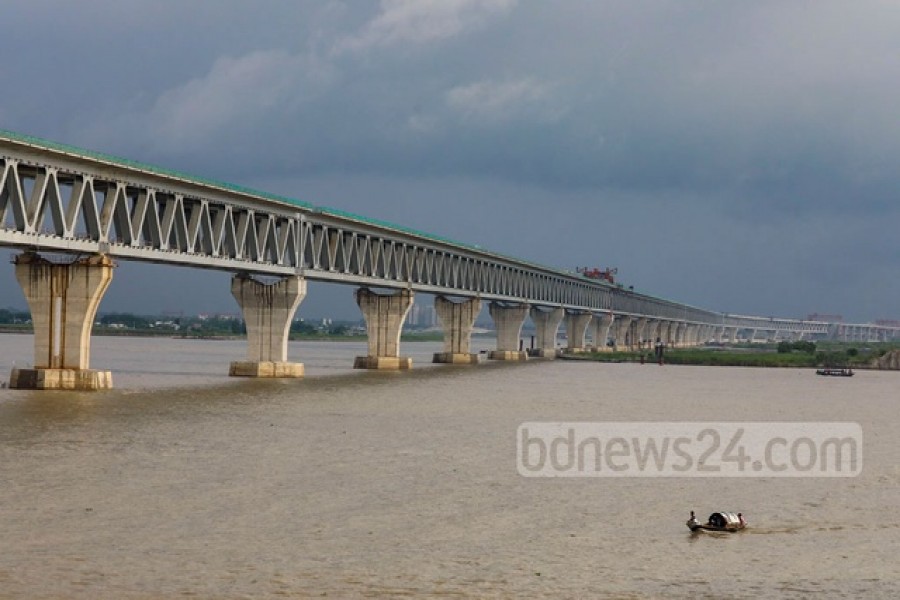
Published :
Updated :

Two flagship bridges of riverine Bangladesh, the Padma Bridge and Bangabandhu Setu, have revolutionised the country's communication. Of the two, the latest to have been opened to traffic is the bridge on the mighty river Padma known for its treacherous shifting soil at its bed. So engineers had to overcome the toughest challenges ever faced anywhere in the world for erecting at least a couple of pillars midstream of the river. Naturally the achievement is worth celebrating and the joy and euphoria have been increased many times over because of the accomplishment of the job with the country's own finance, thanks to Prime Minister Sheikh Hasina's courageous and sagacious decision.
Already people of the south-western districts are overjoyed to have made their Eid journeys home free of the encumbrances and ordeals they had to suffer during the annual festivals each year. Time lapses on the road were almost non-existent because of the expressway up to Bhanga, Faridpur. The other news is that the number of visitors to the Kuakata beach in Patuakhali have increased manifold.
However one piece of news likely to escape public notice concerns the number of vehicles that have crossed the bridge during three days starting from midday Thursday last week and the toll realised from those vehicles. During the three days 74,222 vehicles cruised past the bridge both ways and the toll collection from those stood at Tk 100.98 million. Comparably, 120,350 vehicles coursed on the Bangabandhu Setu opened to traffic in June, 1998 and about Tk 90.19 million was realised as toll. While the Padma Bridge had record toll collection of a little over Tk 40.19 million on Friday, the Bangabandhu Setu also had its record toll realisation of Tk30.35 million between Wednesday midnight and Thursday midnight.
Now what is special about the large amount of toll collection? That toll collection will be higher at a time when the rush is at its heaviest is understandable. This does not necessarily mean that such a large number of vehicles will beeline the bridges in normal times but still the fact is that the highway connecting the Padma Bridge has already witnessed movement of 15 to 20-fold more vehicles. It is likely to go up rather than coming down in the future. The greater is the mobility of people the further the economic progress of a country. Again, the heavy traffic of festival time is a clear evidence of the highway's and the bridge's capacity to handle such emergencies.
The third issue as raised by some quarters questioning the huge investment of $3.86 billion in a single project is the recovery of the invested money. Although the prime minister has claimed the money spent on the bridge and the subsequent maintenance cost will be recovered within 20 years, an initial estimate gives a time frame of 35 years for the recovery of the cost.
However, these are concerns irrelevant to the objective and the multifarious dividends the country will be reaping, courtesy of the bridge. But the issues that are yet to receive enough attention are the complementary, supportive and allied infrastructure, facilities capable of taking the pressure off the capital. Some have raised their voice in favour of a four-lane highway from Bhanga to Kuakata. This will be useful no doubt but the argument looks not as strong as they claim because their prime focus is on facilitation of tourism at Kuakata.
That Dhaka should not be as thickly crowded as it is and a hub of almost every human activity turning it into a terrible urban conundrum has caught the attention of both common people and policymakers. But Dhaka-centric planning has not shown any sign of relenting. The rivers around the capital are either choking or dying because of the excessive human activity and industrial pollution. But for the city's survival, the survivability of the rivers is a must.
Now that the entire country has been connected with road and the railways are expected to follow suit, decentralisation of governance, means of production and employment have to be prioritised. People will leave this crowded and unbearable city to live in smaller but better liveable urban centres if facilities for standard education and medical care can be developed nearby. Under a decentralised system, regional development can be expected to be rational and on an even keel. Thus ICT city, specialised industrial and manufacturing villages after Silicon valley can be built away from the capital.
There is no point investing in more mega projects for the capital. Its population needs dispersal rather than further concentration. True, its entry and exit points can be modernised with inter-city buses not cramming the bus terminals. Those buses must enter one way and exit other way without needing roundabout movement. This will facilitate highway journeys without creating 10-20-mile logjam on the approach roads to bridges. This done, the maximum dividend of highways and bridges like the Padma Bridge can be reaped.
Festival times have ever remained a critical time for home-goers in this country. Because the railways have not seen their network developed and expanded, the bulk pressure of festivals' rush times had to be borne by the road transports and people of the southern districts mostly relied on launch journeys infamous for a most suffocating crammed condition. During this Eid, things have changed reasonably for the better.


 For all latest news, follow The Financial Express Google News channel.
For all latest news, follow The Financial Express Google News channel.